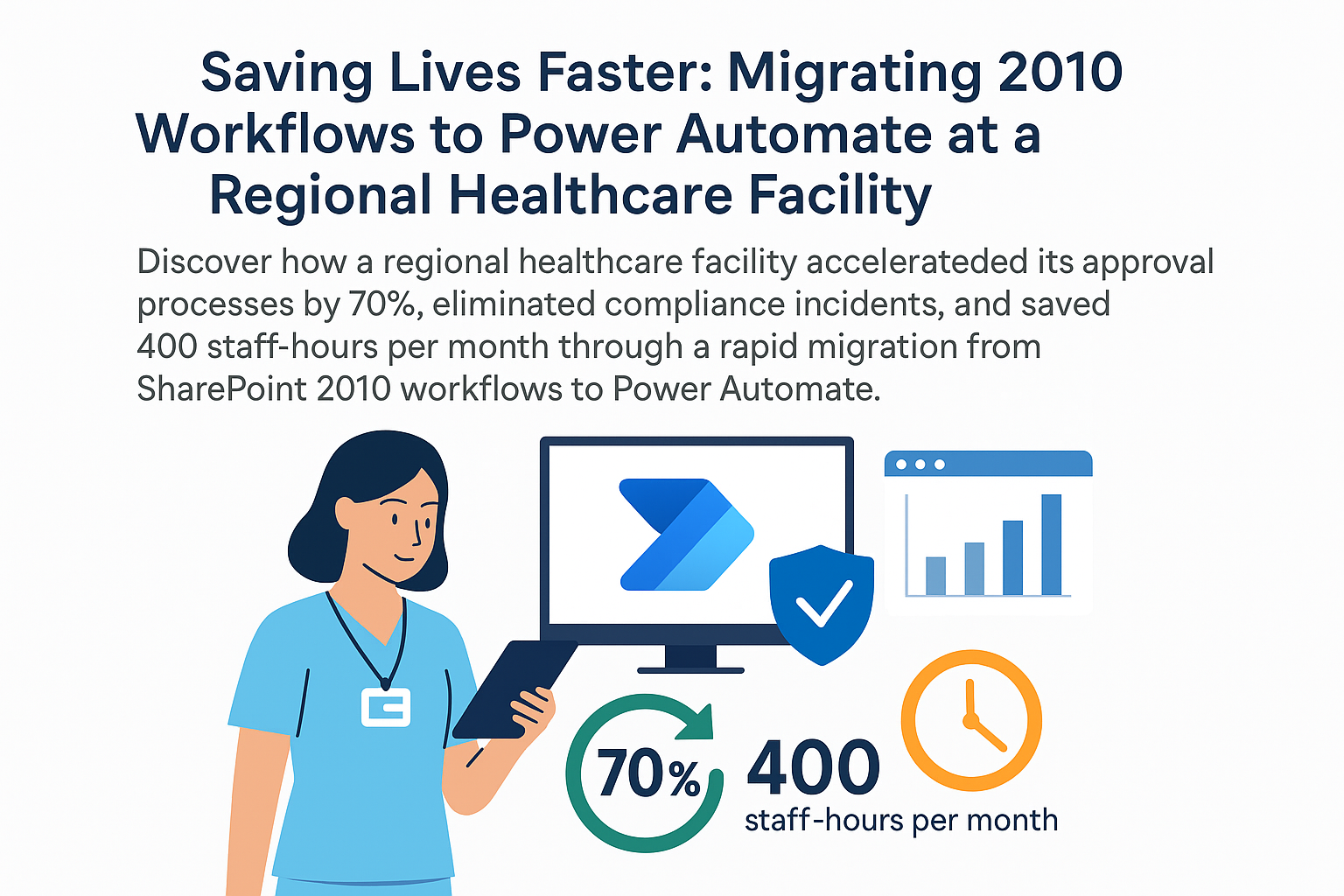
The Healthcare Workflow Crisis
A 400-bed regional healthcare facility relied on SharePoint 2010 workflows for critical processes: supply requisitions, equipment maintenance requests, patient transfer approvals, incident reporting, and dozens of other operational workflows that kept the hospital running.
Then Microsoft announced SharePoint 2010 end of support. The workflows would stop working. The hospital faced a crisis.
Why This Mattered
These were not optional processes. A surgery could not proceed without approved supply requisitions. Equipment failures created safety risks if maintenance requests stalled. Patient transfers required multi-step approvals involving nurses, physicians, and administrators.
The hospital had three options: Stay on unsupported software with mounting security risks. Upgrade to modern SharePoint but rebuild every workflow manually. Or migrate to Power Automate with intelligent automation that improved rather than just replicated old processes.
We helped them choose option three.
Migration Strategy
Rather than panic migrations that disrupt operations, we executed a systematic transformation:
Phase 1: Workflow Analysis and Prioritization
We catalogued all 127 active workflows, understanding business logic, approval chains, and integration points. Then prioritized by criticality and complexity.
Phase 2: Incremental Migration
We migrated workflows in batches, starting with simple processes to build confidence and learn patterns before tackling complex clinical workflows.
Phase 3: Process Improvement
Rather than blindly replicating old logic, we identified improvement opportunities—eliminating unnecessary approval steps, adding mobile capabilities, integrating AI for intelligent routing.
Results were immediate and dramatic.
Impact on Healthcare Operations
Speed and Efficiency:
- Supply requisition approval time: 72 hours → 6 hours (70% reduction)
- Maintenance request response time: 48 hours → 4 hours (92% faster)
- Patient transfer coordination: 3 hours → 20 minutes (89% improvement)
Compliance and Safety:
- Zero compliance incidents (previously 2-3 monthly due to missed approvals)
- Complete audit trails for regulatory inspections
- Automated escalations ensuring critical requests never stall
Operational Savings:
- 400 staff hours saved monthly from process acceleration
- Eliminated overtime for manual workflow monitoring
- Reduced supply costs through faster procurement cycles
Technical Transformation
Power Automate provided capabilities impossible in SharePoint 2010:
Mobile Approvals: Clinicians approve requests from phones rather than returning to workstations, dramatically reducing turnaround time.
Intelligent Routing: AI analyzes request content and routes to appropriate approvers automatically, eliminating manual triage.
Integration: Workflows connect to electronic health records, inventory systems, and facility management platforms—breaking down silos.
Analytics: Power BI dashboards show bottlenecks, volume trends, and process efficiency in real-time.
Change Management Success Factors
Technology transformation succeeds or fails based on user adoption. We focused on change management from day one:
Clinical Champions: Identified respected clinicians to test workflows early and advocate for adoption.
Training: Hands-on sessions showing how new workflows made daily tasks easier, not harder.
Support: Dedicated support team during transition period to address issues immediately.
Quick Wins: Prioritized workflows with clear user benefits to build momentum and enthusiasm.
Unexpected Benefits
As workflows moved to Power Automate, opportunities emerged that nobody anticipated:
Predictive Maintenance: Analysis of equipment maintenance patterns enabled predictive scheduling, reducing emergency repairs.
Supply Optimization: Requisition data revealed usage patterns, enabling smarter inventory management and bulk purchasing savings.
Process Standardization: Migration revealed process variations across departments. Standardization improved quality and reduced training complexity.
Compliance Automation: Regulatory reporting automated using workflow data, saving hours of manual compilation.
ROI and Business Case
The migration paid for itself within 7 months:
- 400 staff hours saved monthly = $200,000 annual labor savings
- Supply cost optimization = $150,000 annual savings
- Eliminated SharePoint 2010 support costs = $75,000 annual savings
- Total annual benefit: $425,000 vs. $180,000 implementation cost
Lessons for Healthcare Organizations
This transformation reinforced several principles for healthcare IT:
Act Before Crisis: Waiting until systems fail creates unnecessary risk. Proactive migration enables thoughtful improvement rather than panic conversion.
Prioritize Clinical Impact: Technology changes succeed when they clearly improve patient care or clinician experience.
Leverage Modern Capabilities: Do not just replicate old processes. Modern platforms enable improvements impossible previously.
Invest in Change Management: Technology is easy. People are hard. Budget adequately for training, support, and cultural adaptation.
Beyond Healthcare
While this case focuses on healthcare, SharePoint 2010 workflow migration challenges are universal. Manufacturing plants running production workflows, financial institutions managing approval processes, and government agencies coordinating multi-department processes all face similar challenges.
The migration methodology works across industries. The technology stack is the same. The benefits—speed, reliability, mobile access, integration, analytics—apply everywhere.
Taking Action
If your organization still relies on SharePoint 2010 workflows or other legacy automation, the clock is ticking. Unsupported software creates mounting security and compliance risks.
Ready to modernize your workflows? Contact QueryNow for a workflow migration assessment. We will inventory your current automation, identify risks and opportunities, and provide a roadmap for migrating to modern Power Automate with improved capabilities and reduced risk.


